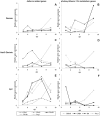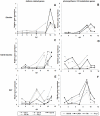Dynamics of responses in compatible potato-Potato virus Y interaction are modulated by salicylic acid
- PMID: 22194976
- PMCID: PMC3237580
- DOI: 10.1371/journal.pone.0029009
Dynamics of responses in compatible potato-Potato virus Y interaction are modulated by salicylic acid
Abstract
To investigate the dynamics of the potato-Potato virus Y (PVY) compatible interaction in relation to salicylic acid-controlled pathways we performed experiments using non-transgenic potato cv. Désirée, transgenic NahG-Désirée, cv. Igor and PVY(NTN), the most aggressive strain of PVY. The importance of salicylic acid in viral multiplication and symptom development was confirmed by pronounced symptom development in NahG-Désirée, depleted in salicylic acid, and reversion of the effect after spraying with 2,6-dichloroisonicotinic acid (a salicylic acid-analogue). We have employed quantitative PCR for monitoring virus multiplication, as well as plant responses through expression of selected marker genes of photosynthetic activity, carbohydrate metabolism and the defence response. Viral multiplication was the slowest in inoculated potato of cv. Désirée, the only asymptomatic genotype in the study. The intensity of defence-related gene expression was much stronger in both sensitive genotypes (NahG-Désirée and cv. Igor) at the site of inoculation than in asymptomatic plants (cv. Désirée). Photosynthesis and carbohydrate metabolism gene expression differed between the symptomatic and asymptomatic phenotypes. The differential gene expression pattern of the two sensitive genotypes indicates that the outcome of the interaction does not rely simply on one regulatory component, but similar phenotypical features can result from distinct responses at the molecular level.
Conflict of interest statement
Figures




Similar articles
-
Salicylic acid is an indispensable component of the Ny-1 resistance-gene-mediated response against Potato virus Y infection in potato.J Exp Bot. 2014 Mar;65(4):1095-109. doi: 10.1093/jxb/ert447. Epub 2014 Jan 13. J Exp Bot. 2014. PMID: 24420577 Free PMC article.
-
Bimodal dynamics of primary metabolism-related responses in tolerant potato-Potato virus Y interaction.BMC Genomics. 2015 Sep 19;16(1):716. doi: 10.1186/s12864-015-1925-2. BMC Genomics. 2015. PMID: 26386579 Free PMC article.
-
Multiomics analysis of tolerant interaction of potato with potato virus Y.Sci Data. 2019 Oct 31;6(1):250. doi: 10.1038/s41597-019-0216-1. Sci Data. 2019. PMID: 31673114 Free PMC article.
-
Continuous and emerging challenges of Potato virus Y in potato.Annu Rev Phytopathol. 2013;51:571-86. doi: 10.1146/annurev-phyto-082712-102332. Annu Rev Phytopathol. 2013. PMID: 23915135 Review.
-
Plant Molecular Responses to Potato Virus Y: A Continuum of Outcomes from Sensitivity and Tolerance to Resistance.Viruses. 2020 Feb 15;12(2):217. doi: 10.3390/v12020217. Viruses. 2020. PMID: 32075268 Free PMC article. Review.
Cited by
-
A Non-Canonical Pathway Induced by Externally Applied Virus-Specific dsRNA in Potato Plants.Int J Mol Sci. 2023 Oct 30;24(21):15769. doi: 10.3390/ijms242115769. Int J Mol Sci. 2023. PMID: 37958754 Free PMC article.
-
Protective and Curative Activities of Paenibacillus polymyxa against Zucchini yellow mosaic virus Infestation in Squash Plants.Biology (Basel). 2022 Jul 30;11(8):1150. doi: 10.3390/biology11081150. Biology (Basel). 2022. PMID: 36009777 Free PMC article.
-
Salicylic acid is an indispensable component of the Ny-1 resistance-gene-mediated response against Potato virus Y infection in potato.J Exp Bot. 2014 Mar;65(4):1095-109. doi: 10.1093/jxb/ert447. Epub 2014 Jan 13. J Exp Bot. 2014. PMID: 24420577 Free PMC article.
-
Bacillus amyloliquefaciens strain MBI600 induces salicylic acid dependent resistance in tomato plants against Tomato spotted wilt virus and Potato virus Y.Sci Rep. 2018 Jul 9;8(1):10320. doi: 10.1038/s41598-018-28677-3. Sci Rep. 2018. PMID: 29985434 Free PMC article.
-
A plant RNA virus inhibits NPR1 sumoylation and subverts NPR1-mediated plant immunity.Nat Commun. 2023 Jun 16;14(1):3580. doi: 10.1038/s41467-023-39254-2. Nat Commun. 2023. PMID: 37328517 Free PMC article.
References
-
- Singh RP, Valkonen JPT, Gray SM, Boonham N, Jones RAC, et al. Discussion paper: The naming of Potato virus Y strains infecting potato. Arch Virol. 2008;153:1–13. - PubMed
-
- Whitham SA, Yang C, Goodin MM. Global impact: elucidating plant responses to viral infection. Mol Plant Microbe Interact. 2006;19:1207–1215. - PubMed
-
- Lewsey M, Palukaitis P, Carr JP. Plant - virus interactions: defence and counter-defence. In: Parker J, editor. Molecular Aspects of Plant Disease Resistance. Oxford: Wiley-Blackwell; 2009. pp. 134–176.
-
- Vlot AC, Dempsey DA, Klessig DF. Salicylic Acid, a multifaceted hormone to combat disease. Annu Rev Phytopathol. 2009;47:177–206. - PubMed
-
- Singh DP, Moore CA, Gilliland A, Carr JP. Activation of multiple antiviral defence mechanisms by salicylic acid. Mol Plant Pathol. 2004;5:57–63. - PubMed
Publication types
MeSH terms
Substances
LinkOut - more resources
Full Text Sources
Research Materials

